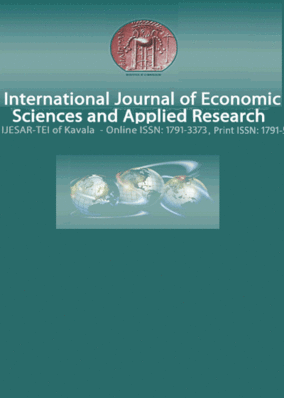Fear of Floating and Inflation Targeting in Turkey
Part of : International Journal of Business and Economic Sciences Applied Research ; Vol.7, No.3, 2014, pages 25-42
Issue:
Pages:
25-42
Author:
Abstract:
The objective of this paper is to test empirical validity of Fear of Floating hypothesis for Turkey after the adoption of Inflation Targeting. We start applying methodologies developed by Calvo and Reinhart (2002) and Ball and Reyes (2004, 2008) to check the probabilities of changes in exchange rate and monetary policy instruments before and after inflation targeting regime. We then use a VAR model to estimate exchange rate pass-through and response of monetary policy instruments to exchange rate shocks before and after inflation targeting regime. VAR model helps to understand the impacts of switch in monetary policy regime on exchange rate passthrough and foreign exchange market interventions. The paper concludes that after the adoption of inflation targeting regime, the exchange rate pass-through still matters for the attainment of inflation targets and the monetary policy do not exhibit a fear of floating practices.
Subject:
Subject (LC):
Keywords:
Fear of floating, fear of inflation, exchange rate pass-through, free floating exchange rate
Notes:
JEL Classification: F31, E31, E58
References (1):
- Bailliu, J. & Fujii, E., 2004, 'Exchange Rate Pass-Through and the Inflation Environment in industrialized Countries: An Empirical Investigation', Bank of Canada Working Paper 2004-21.Ball, C. & Reyes J., 2004, 'Inflation Targeting or Fear of Floating in Disguise: The Case of Mexico', Internationaljournal of Finance and Economics, 9, pp. 49-69.Ball, C. & Reyes J., 2008, 'Inflation Targeting or Fear of Floating in Disguise? A broader perspective', Journal of Macroeconomics, 30, pp. 308-326.Baqueiro, Α., de Leon A. D. & Torres Α., 2003, 'Fear of Floating or Fear of Inflation? The role of the exchange rate pass-through', Central Bank of Mexico. BIS Papers No 19.Berument, H. & Tasci, H., 2004, 'Monetary policy rules in practice: evidence from Turkey', International Journal of Finance and Economics, 9, pp. 33-8.Calvo A. G. & Mishkin F. S., 2003, 'The Mirage of Exchange Rate Regimes for Emerging Market Countries', The Journal of Economic Perspectives, 17, 4, pp. 99-118.Calvo A. G. & Reinhart CM., 2002, 'Fear of Floating', The Quarterly Journal of Economics, 117, 2, pp. 379-408.Campa, J. & Goldberg L., 2002, 'Exchange Rate Pass-Through Into Import Prices: A Macro or Micro Phenomenon?', NBER Working Paper No. 8934, pp. 1-34.Choudhri E.U., & Hakura D.S., 2001, 'Exchange Rate Pass-Through to Domestic Prices: Does the Inflationary Environment Matter?', IMF Working Paper, WP/01/194, pp. 1-36.Civcir, I., & Akçaglayan, Α., 2010, 'Inflation Targeting and the Exchange Rate: Does it matter in Turkey?', Journal of Policy Modeling, 32, pp. 339-354.Devereux, M., Engel, C. & Storgaard, P., 2003, 'Endogenous Exchange Rate Pass-Through When Nominal Prices Are Set in Advance', NBER Working Paper No. 9543, pp. 1-44.Devereux, M. B., & Yetman, J., 2002, 'Price-Setting and Exchange Rate Pass-Through: Theory and Evidence', HKIMR Working Paper No.22/2002, pp. 1-22.Edwards, S., 2002, 'The great exchange rate debate after Argentina', North American Journal of Economics and Finance, 13, pp. 237-252.Eichengreen, B., 2002, 'Can emerging markets float? Should they inflation target?', Central Bank of Brazil -Working Paper Series N:36.Fraga, Α., I. Goldfajn, & Minella, Α., 2003, 'Inflation Targeting in emerging market economies', NBER Working Paper No. 10019.Gagnon, J. & Ihrig, J., 2004, 'Monetary Policy and Exchange Rate Pass-Through', International Journal of Finance and Economics, 9, pp. 315-338.Goldfajn, I. & Werlang, S., 2000, 'The pass-through from depreciation to inflation: a panel study', Central Bank of Brazil- Working Paper No. 05.Edwards, S., 2002, 'The great exchange rate debate after Argentina', The North American Journal of Economics and Finance, 13, pp. 237-252.Kara, H. and Ögünc F., 2008, 'Inflation Targeting and Exchange Rate Pass-Through: The Turkish Experience', Emerging Markets Finance and Trade, 44, 6, pp. 52-66.Levy-Yeyati, E. & Sturzenegger, F., 2007, 'Fear of Floating in Reverse: Exchange Rate Policy in the 2000s', The World Bank and UTDT, Mimeo.Mishkin, F. S., 2004, 'Can Inflation Targeting Work in Emerging Market Countries?', NBER Working Paper No. 10646.Nogueira Jr, R. P. and Leon-Ledesma Μ. Α., 2009, 'Fear of Floating in Brazil: Did Inflation Targeting matter?', The North American Journal of Economics and Finance, 20, 3, pp. 255-266.Reyes, J., 2007, 'Exchange rate pass-through effect and Inflation Targeting in emerging economies: What is the relationship?', Review of International Economics, 15, pp. 538-559.Sims, C.A. and Zha T., 1999, 'Error Bands for Impulse Responses', Econometrica, 67, 5, pp. 1113-1155.Schmidt-Hebbel, Κ., & Tapia, M., 2002, 'Inflation targeting in Chile', The North American Journal of Economics and Finance, 13, pp. 125-146.Us, V., 2004, 'Inflation Dynamics and Monetary Policy Strategy: Some Prospects for Turkish the Economy', Journal of Policy Modelling, 26, pp. 1003-1013.Us, V., 2007, 'Alternative Monetary Policy Rules in the Turkish Economy under an Inflation-Targeting Framework', Emerging Market Finance and Trade, 43,2, pp. 82-10.Taylor, J.B., 2000, 'Low Inflation, Pass-Through, and the Pricing Power of Firms', European Economic Review, 44, 7, pp. 1389-1408.Yazgan, M. E., & Yilmazkuday, H., 2007, 'Monetary Policy Rules in Practice: Evidence from Turkey and Israel', Applied Financial Economics, 17, pp. 1-8.Yüncüler, Ç ., 2011, 'Pass-Through of External Factors into Price Indicators in Turkey', Central Bank Review, 11, 2, pp. 71-84.




